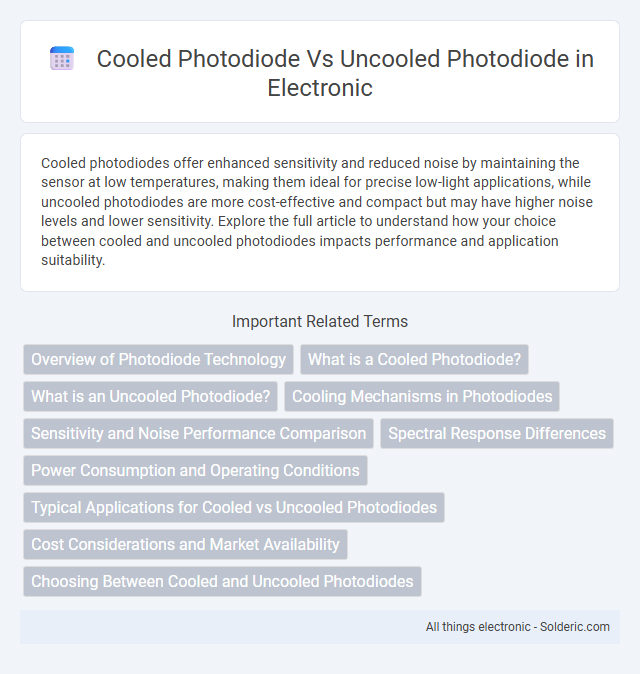Cooled photodiodes offer enhanced sensitivity and reduced noise by maintaining the sensor at low temperatures, making them ideal for precise low-light applications, while uncooled photodiodes are more cost-effective and compact but may have higher noise levels and lower sensitivity. Explore the full article to understand how your choice between cooled and uncooled photodiodes impacts performance and application suitability.
Comparison Table
| Feature | Cooled Photodiode | Uncooled Photodiode |
|---|---|---|
| Temperature Control | Active cooling (thermoelectric cooler) | Ambient temperature operation |
| Noise Level | Low thermal noise | Higher thermal noise |
| Sensitivity | High sensitivity, better signal-to-noise ratio | Moderate sensitivity |
| Response Time | Typically faster response | Moderate response time |
| Cost | Higher due to cooling system | Lower cost, simple design |
| Applications | High-precision spectroscopy, astronomy, scientific research | Consumer electronics, general light detection, industrial sensors |
| Power Consumption | Higher, due to cooling element | Lower, no cooling needed |
| Size and Complexity | Larger and more complex | Compact and simpler |
Overview of Photodiode Technology
Cooled photodiodes utilize thermoelectric or cryogenic cooling systems to reduce thermal noise, significantly enhancing sensitivity and signal-to-noise ratio in low-light or high-precision applications. Uncooled photodiodes operate at ambient temperature, providing cost-effective and compact solutions ideal for general-purpose light detection without the need for additional cooling hardware. Understanding these differences in photodiode technology helps you select the right sensor based on performance requirements and environmental conditions.
What is a Cooled Photodiode?
A cooled photodiode is a semiconductor device equipped with a temperature control mechanism, typically a thermoelectric cooler, to reduce its operating temperature and minimize thermal noise. This cooling significantly enhances sensitivity and signal-to-noise ratio, making it ideal for low-light or high-precision optical detection applications. Unlike uncooled photodiodes, which operate at ambient temperatures and exhibit higher noise levels, cooled photodiodes deliver greater accuracy and stability in demanding environments.
What is an Uncooled Photodiode?
An uncooled photodiode is a semiconductor device that detects light without the need for temperature regulation. These photodiodes operate at ambient temperatures, offering cost-effectiveness and simplicity compared to cooled photodiodes. Uncooled photodiodes are commonly used in applications where moderate sensitivity and faster response times are acceptable without the complexity of cooling systems.
Cooling Mechanisms in Photodiodes
Cooled photodiodes utilize thermoelectric coolers or liquid nitrogen systems to reduce the junction temperature, significantly lowering thermal noise and enhancing sensitivity in low-light conditions. Uncooled photodiodes rely on ambient temperature, which results in higher dark current and noise, limiting their performance in precision applications. The cooling mechanism in cooled photodiodes improves signal-to-noise ratio, making them ideal for infrared detection and scientific instrumentation.
Sensitivity and Noise Performance Comparison
Cooled photodiodes exhibit significantly higher sensitivity due to reduced thermal noise, enabling more accurate signal detection in low-light conditions compared to uncooled photodiodes. The cooling process lowers dark current, which minimizes noise levels and enhances signal-to-noise ratio (SNR), making cooled photodiodes ideal for precision applications like spectroscopy and infrared detection. Uncooled photodiodes, while simpler and more cost-effective, typically have higher noise floors that limit their effectiveness in low-signal or high-precision environments.
Spectral Response Differences
Cooled photodiodes exhibit enhanced spectral response with reduced noise and higher sensitivity, especially in the infrared range, due to lower thermal-generated charge carriers. Uncooled photodiodes generally have a broader spectral response but suffer from increased noise, which can limit detection accuracy in low-light or precise applications. Your choice between cooled and uncooled photodiodes depends heavily on the required sensitivity and the specific wavelength range of interest.
Power Consumption and Operating Conditions
Cooled photodiodes consume more power due to the need for integrated cooling systems, typically using thermoelectric coolers to maintain optimal operating temperatures, resulting in enhanced sensitivity and reduced noise levels. Uncooled photodiodes operate efficiently at ambient temperatures without additional power for cooling, making them more suitable for applications where energy efficiency and simpler system designs are critical. Your choice depends on the trade-off between power consumption constraints and performance requirements under varying environmental conditions.
Typical Applications for Cooled vs Uncooled Photodiodes
Cooled photodiodes are typically used in high-precision applications such as scientific research, spectroscopy, and astronomy, where low noise and high sensitivity are critical. Uncooled photodiodes are commonly found in consumer electronics, industrial automation, and environmental monitoring, offering cost-effective and reliable performance without the need for temperature control. Your choice between cooled and uncooled photodiodes should align with the sensitivity and noise requirements of your specific application.
Cost Considerations and Market Availability
Cooled photodiodes typically incur higher costs due to the integration of thermoelectric cooling systems, specialized packaging, and complex manufacturing processes, making them less accessible in general consumer markets. Uncooled photodiodes offer a more cost-effective solution with widespread availability, favored in applications where budget constraints exist and moderate performance suffices. Market analysis shows that uncooled photodiodes dominate sectors like consumer electronics and automotive sensing, while cooled photodiodes are prevalent in high-precision scientific instruments and military-grade technologies.
Choosing Between Cooled and Uncooled Photodiodes
Choosing between cooled and uncooled photodiodes depends on your application's sensitivity and noise requirements. Cooled photodiodes offer significantly lower dark current and noise levels, enhancing signal detection in low-light or high-precision environments like spectroscopy or astronomy. Uncooled photodiodes provide cost-effective, compact solutions suitable for general-purpose applications where moderate sensitivity and faster response are sufficient.
Cooled photodiode vs Uncooled photodiode Infographic

 solderic.com
solderic.com